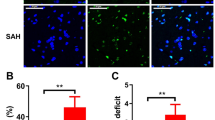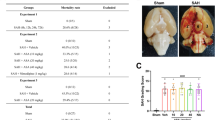Abstract
Subarachnoid hemorrhage (SAH) is a devastating cerebral vascular disease which causes neurological deficits including long-term cognitive deficit. Demyelination of white matter is correlated with cognitive deficit in SAH. Electroacupuncture (EA) is a traditional Chinese medical treatment which protects against cognitive deficit in varies of neurological diseases. However, whether EA exerts protective effect on cognitive function in SAH has not been investigated. The underlying mechanism of remyelination regulated by EA remains unclear. This study aimed to investigate the protective effects of EA on cognitive deficit in a rat model of SAH. SAH was induced in SD rats (n = 72) by endovascular perforation. Rats in EA group received EA treatment (10 min per day) under isoflurane anesthesia after SAH. Rats in SAH and sham groups received the same isoflurane anesthesia with no treatment. The mortality rate, neurological score, cognitive function, cerebral blood flow (CBF), and remyelination in sham, SAH and EA groups were assessed at 21 d after SAH.EA treatment alleviated cognitive deficits and myelin injury of rats compared with that in SAH group. Moreover, EA treatment enhanced remyelination in white matter and promoted the differentiation of OPCs after SAH. EA treatment inhibited the expression of Id2 and promoted the expression of SOX10 in oligodendrocyte cells. Additionally, the cerebral blood flow (CBF) of rats was increased by EA compared with that in SAH group. EA treatment exerts protective effect against cognitive deficit in the late phase of SAH. The underlying mechanisms involve promoting oligodendrocyte progenitor cell (OPC) differentiation and remyelination in white matter via regulating the expression of Id2 and SOX10. The improvement of CBF may also account for the protective effect of EA on cognitive function. EA treatment is a potential therapy for the treatment of cognitive deficit after SAH.





Similar content being viewed by others
Data availability
The data that support the findings of this study are not openly available due to privacy protection and are available from the corresponding author upon reasonable request .
Abbreviations
- SAH:
-
Subarachnoid hemorrhage
- EA:
-
Electroacupuncture
- CBF:
-
Cerebral blood flow
- OPC:
-
Oligodendrocyte progenitor cell
- TBI:
-
Traumatic brain injury
- MBP:
-
Myelin basic protein
- APP:
-
Amyloid precursor protein
- CCA:
-
Common carotid artery
- ECA:
-
External carotid artery
- ICA:
-
Internal carotid artery
- AC:
-
Anterior cerebral artery
- MWM:
-
Morris water maze
- TEM:
-
Transmission electron microscopy
- LTP:
-
Long-term potentiation
References
Ahn SM, Kim YR, Kim HN, Shin YI, Shin HK, Choi BT (2016) Electroacupuncture ameliorates memory impairments by enhancing oligodendrocyte regeneration in a mouse model of prolonged cerebral hypoperfusion. Sci Rep 6:28646. Published 2016 Jun 28. https://doi.org/10.1038/srep28646
Buffo A, Vosko MR, Ertürk D et al (2005) Expression pattern of the transcription factor Olig2 in response to brain injuries: implications for neuronal repair. Proc Natl Acad Sci USA 102(50):18183–18188. https://doi.org/10.1073/pnas.0506535102
Bouhrara M, Reiter DA, Bergeron CM et al (2018) Evidence of demyelination in mild cognitive impairment and dementia using a direct and specific magnetic resonance imaging measure of myelin content. Alzheimers Dement 14(8):998–1004. https://doi.org/10.1016/j.jalz.2018.03.007
Cai M, Lee JH, Yang EJ (2019) Electroacupuncture attenuates cognition impairment via anti-neuroinflammation in an Alzheimer’s disease animal model. J Neuroinflammation 16(1):264. Published 2019 Dec 13. https://doi.org/10.1186/s12974-019-1665-3
Chavez LM, Huang SS, MacDonald I, Lin JG, Lee YC, Chen YH (2017) Mechanisms of acupuncture therapy in ischemic stroke rehabilitation: a literature review of basic studies. Int J Mol Sci 18(11):2270. Published 2017 Oct 28. https://doi.org/10.3390/ijms18112270
Chen JF, Liu K, Hu B et al (2021) Enhancing myelin renewal reverses cognitive dysfunction in a murine model of Alzheimer’s disease. Neuron 109(14):2292-2307e5. https://doi.org/10.1016/j.neuron.2021.05.012
Chen S, Feng H, Sherchan P et al (2014) Controversies and evolving new mechanisms in subarachnoid hemorrhage. Prog Neurobiol 115:64–91. https://doi.org/10.1016/j.pneurobio.2013.09.002
Chen XS, Zhang YH, Cai QY, Yao ZX (2012) ID2: A negative transcription factor regulating oligodendroglia differentiation. J Neurosci Res 90(5):925–932. https://doi.org/10.1002/jnr.22826
Darwazeh R, Wei M, Zhong J et al (2018) Significant injury of the mammillothalamic tract without injury of the corticospinal tract after aneurysmal subarachnoid hemorrhage: a retrospective diffusion tensor imaging study. World Neurosurg 114:e624–e630. https://doi.org/10.1016/j.wneu.2018.03.042
Egashira Y, Zhao H, Hua Y et al (2015) White matter injury after subarachnoid hemorrhage: role of blood-brain barrier disruption and matrix metalloproteinase-9. Stroke 46:2909–2915
Eijlers AJC, van Geest Q, Dekker I et al (2018) Predicting cognitive decline in multiple sclerosis: a 5-year follow-up study. Brain 141(9):2605–2618. https://doi.org/10.1093/brain/awy202
Feiler S, Friedrich B, Scholler K, Thal SC, Plesnila N (2010) Standardized induction of subarachnoid hemorrhage in mice by intracranial pressure monitoring. J Neurosci Methods 190(2):164–170
Han X, Gao Y, Yin X et al (2021) The mechanism of electroacupuncture for depression on basic research: a systematic review [published correction appears in Chin Med. Feb 10;16(1):20]. Chin Med 16(1):10. Published 2021 Jan 13. https://doi.org/10.1186/s13020-020-00421-y
Hornig J, Frob F, Vogl MR, Hermans-Borgmeyer I, Tamm ER, Wegner M (2013) The transcription factors Sox10 and Myrf define an essential regulatory network module in differentiating oligodendrocytes. PLoS Genet 9:e1003644
Huang S, Tang C, Sun S et al (2015) Protective effect of electroacupuncture on neural myelin sheaths is mediated via promotion of oligodendrocyte proliferation and inhibition of oligodendrocyte death after compressed spinal cord injury. Mol Neurobiol 52(3):1870–1881. https://doi.org/10.1007/s12035-014-9022-0
Hubler Z, Allimuthu D, Bederman I et al (2018) Accumulation of 8,9-unsaturated sterols drives oligodendrocyte formation and remyelination. Nature 560(7718):372–376. https://doi.org/10.1038/s41586-018-0360-3
Jessen KR, Mirsky R (2008) Negative regulation of myelination: relevance for development, injury, and demyelinating disease. Glia 56(14):1552–1565. https://doi.org/10.1002/glia.20761
Jeon H, Ai J, Sabri M et al (2010) Learning deficits after experimental subarachnoid hemorrhage in rats. Neuroscience 169:1805–1814
Keller TA, Just MA (2009) Altering cortical connectivity: remediation-induced changes in the white matter of poor readers. Neuron 64(5):624–631. https://doi.org/10.1016/j.neuron.2009.10.018
Kou Z, VandeVord PJ (2014) Traumatic white matter injury and glial activation: from basic science to clinics. Glia 62(11):1831–1855. https://doi.org/10.1002/glia.22690
Kuhn S, Gritti L, Crooks D, Dombrowski Y (2019) Oligodendrocytes in development, myelin generation and beyond. Cells 8(11):1424. Published 2019 Nov 12. https://doi.org/10.3390/cells8111424
Kummer TT, Magnoni S, MacDonald CL et al (2015) Experimental subarachnoid haemorrhage results in multifocal axonal injury. Brain 138:2608–2618
Lee DH, Cho SY, Yang SB et al (2020) Efficacy of acupuncture treatment to prevent cerebral vasospasm after subarachnoid hemorrhage: a double-blind, randomized placebo-controlled trial. J Altern Complement Med 26(12):1182–1189. https://doi.org/10.1089/acm.2020.0156
Lipscomb DC, Gorman LG, Traystman RJ, Hurn PD (1998) Low molecular weight iron in cerebral ischemic acidosis in vivo. Stroke 29(2):487–493. https://doi.org/10.1161/01.str.29.2.487
Li Q, Brus-Ramer M, Martin JH, McDonald JW (2010) Electrical stimulation of the medullary pyramid promotes proliferation and differentiation of oligodendrocyte progenitor cells in the corticospinal tract of the adult rat. Neurosci Lett 479(2):128–133. https://doi.org/10.1016/j.neulet.2010.05.043
Liu AJ, Li JH, Li HQ et al (2015) Electroacupuncture for acute ischemic stroke: a Meta527 analysis of randomized controlled trials. Am J Chin Med 528(8):1541–1566
Liu H, Sun X, Zou W, Leng M, Zhang B, Kang X, He T, Wang H (2017) Scalp acupuncture attenuates neurological deficits in a rat model of hemorrhagic stroke. Complement Ther Med 32:85–90
Liu S, Wang Z, Su Y et al (2021) A neuroanatomical basis for electroacupuncture to drive the vagal-adrenal axis. Nature 598(7882):641–645. https://doi.org/10.1038/s41586-021-04001-4
Ma SM, Wang L, Su XT et al (2020) Acupuncture improves white matter perfusion and integrity in rat model of vascular dementia: an MRI-based imaging study. Front Aging Neurosci 12:582904. https://doi.org/10.3389/fnagi.2020.582904. Published 2020 Nov 23
Monje M (2018) Myelin plasticity and nervous system function. Annu Rev Neurosci 41:61–76. https://doi.org/10.1146/annurev-neuro-080317-061853
Parra MJ, McGirt H, Sheng DT, Laskowitz RD, Pearlstein DS, Warner (2002) Mouse model of subarachnoid hemorrhage associated cerebral vasospasm: methodological analysis. Neurol Res 24:510–516
Peng JH, Qin XH, Pang JW et al (2017) Apolipoprotein E ε4: a possible risk factor of intracranial pressure and white matter perfusion in good-grade aneurysmal subarachnoid hemorrhage patients at early stage. Front Neurol 8:150. https://doi.org/10.3389/fneur.2017.00150. Published 2017 Apr 19
Piao J, Major T, Auyeung G et al (2015) Human embryonic stem cell-derived oligodendrocyte progenitors remyelinate the brain and rescue behavioral deficits following radiation. Cell Stem Cell 16(2):198–210. https://doi.org/10.1016/j.stem.2015.01.004
Pu A, Stephenson EL, Yong VW (2018) The extracellular matrix: Focus on oligodendrocyte biology and targeting CSPGs for remyelination therapies. Glia 66(9):1809–1825. https://doi.org/10.1002/glia.23333
Reijmer YD, van den Heerik MS, Heinen R et al (2018) Microstructural white matter abnormalities and cognitive impairment after aneurysmal subarachnoid hemorrhage. Stroke 49(9):2040–2045. https://doi.org/10.1161/STROKEAHA.118.021622
Ross SE, Greenberg ME, Stiles CD (2003) Basic helix-loop-helix factors in cortical development. Neuron 39(1):13–25
Sock E, Wegner M (2019) Transcriptional control of myelination and remyelination. Glia 67(11):2153–2165. https://doi.org/10.1002/glia.23636
Ulloa L, Quiroz-Gonzalez S, Torres-Rosas R (2017) Nerve stimulation: immunomodulation and control of inflammation. Trends Mol Med 23(12):1103–1120. https://doi.org/10.1016/j.molmed.2017.10.006
Wang F, Ren SY, Chen JF et al (2020) Myelin degeneration and diminished myelin renewal contribute to age-related deficits in memory. Nat Neurosci 23(4):481–486. https://doi.org/10.1038/s41593-020-0588-8
Wang HL, Liu FL, Li RQ et al (2021) Electroacupuncture improves learning and memory functions in a rat cerebral ischemia/reperfusion injury model through PI3K/Akt signaling pathway activation. Neural Regen Res 16(6):1011–1016. https://doi.org/10.4103/1673-5374.300454
Wu Y, Peng J, Pang J, Sun X, Jiang Y (2017) Potential mechanisms of white matter injury in the acute phase of experimental subarachnoid haemorrhage. Brain 140(6):e36. https://doi.org/10.1093/brain/awx084
Xin W, Chan JR (2020) Myelin plasticity: sculpting circuits in learning and memory. Nat Rev Neurosci 21(12):682–694. https://doi.org/10.1038/s41583-020-00379-8
Zhang B, Dai XH, Yu XP et al (2018) Baihui (DU20)-penetrating-Qubin (GB7) acupuncture inhibits apoptosis in the perihemorrhagic penumbra. Neural Regen Res 13(9):1602–1608. https://doi.org/10.4103/1673-5374.237123
Zhu Y, Deng L, Tang H et al (2017) Electroacupuncture improves neurobehavioral function and brain injury in rat model of intracerebral hemorrhage. Brain Res Bull 131:123–132. https://doi.org/10.1016/j.brainresbull.2017.04.003
Acknowledgements
We grant our gratitude to Siqin Huang(Traditional Chinese Medicine College, Chongqing Medical University, Chongqing, China) and her team for their help of instructing us to use electroacupuncture.
Funding
This work was supported by the National Natural Science Foundation of China (No.81901210 No.82071332 and No.82071397), the Science and Technology Research Program of Chongqing Municipal Education Commission (Grant No.KJQN202000428 and Grant No.CYS22342).
Author information
Authors and Affiliations
Contributions
YW, XCS, SQS, and ZDG contributed the conception and design of the study. YYW, XMY, YCC, XGL, RX and JY organized the database. YYW and XMY performed the statistical analysis. YYW and XMY wrote the first draft of the manuscript. YYW, XMY, YCC, XGL, RX, and JY wrote the sections of the manuscript. YW and XCS contributed to manuscript revision, read and approved the submitted version. All authors read and approved the final manuscript.
Corresponding authors
Ethics declarations
Ethical approval
All procedures were approved by the Institutional Animal Care and Use Committee (IACUC) at the Chongqing Medical University.
Consent for publication
All authors discussed the results and commented on the manuscript. Neither the article nor portions of it have been previously published elsewhere. The manuscript is not under consideration for publication in another journal, and will not be submitted elsewhere until the “Metabolic Brain Disease” editorial process is completed, and all authors consent to the publication of the manuscript in “Metabolic Brain Disease”.
Conflict of interest
The authors declare that they have no conflicts of interest.
Additional information
Publisher’s note
Springer Nature remains neutral with regard to jurisdictional claims in published maps and institutional affiliations.
Rights and permissions
Springer Nature or its licensor (e.g. a society or other partner) holds exclusive rights to this article under a publishing agreement with the author(s) or other rightsholder(s); author self-archiving of the accepted manuscript version of this article is solely governed by the terms of such publishing agreement and applicable law.
About this article
Cite this article
Wang, Y., Yang, X., Cao, Y. et al. Electroacupuncture promotes remyelination and alleviates cognitive deficit via promoting OPC differentiation in a rat model of subarachnoid hemorrhage. Metab Brain Dis 38, 687–698 (2023). https://doi.org/10.1007/s11011-022-01102-5
Received:
Accepted:
Published:
Issue Date:
DOI: https://doi.org/10.1007/s11011-022-01102-5




